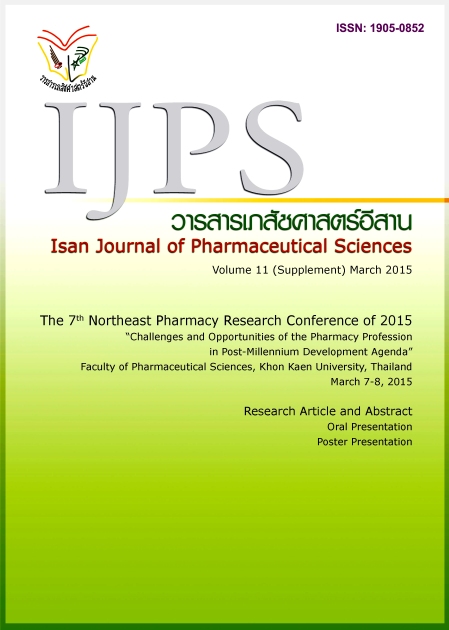In vivo Wound Healing Effects of Formulated Creams Containing Ethyl Acetate Extract of Curcuma cf. comosa Roxb
Main Article Content
Abstract
Introduction: Curcuma cf. comosa Roxb or “Wan-ma-wor” is a traditional herb that commonly used in Northeastern part of Thailand and Cambodia for the treatment of wound. The objective of this study was to investigate for in vivo wound healing effects of formulated cream containing ethyl acetate extract of C. cf. comosa Roxb. Materials and Method: Extract was formulated to creams with the concentration of 5%, 10%, 15% and 20% w/w. Those formulas were tested for stability by heating-cooling cycle method. They were evaluated for appearance, pH, viscosity and amount of active substances remaining in formulas by High Pressure Liquid Chromatography. The formulas having good stability were chosen to study for in vivo wound healing effects. Both ears of 8 weeks old of C57BL/6 mice were punched to make a hole with 2-millimeters of diameter by metal ear punch. Creams were applied to wounds once a day for 30 days. Left ear was applied with the control of cream base. Right ear was applied with formulated cream containing ethyl acetate extract of C. cf. comosa Roxb (n=6/group). Wound healing effects were determined by taking photographs and measuring the diameter of the wounds that be calculated into % of wound healing. The pathological effects of histology of these ears were also examined at day 0, 2, 10, 20. Results: The formulated creams containing 5% and 10% w/w of curcuma extract had the appearance and viscosity better than that of 15% and 20% w/w. But the results of pH and amount of active substances remaining in formulas were not different. Then 5% and 10% w/w of curcuma extract creams were chosen to study for in vivo wound healing effects. Results showed that 5% and 10% w/w of curcuma extract creams had indifferent of %wound healing about 66.67% and 62.12% at the day of 30, respectively. But both formulas had significantly wound healing effects better than the control (p<0.05). The histological effects expressed that tissues around the wound area of treatment groups were found PMNs, fibroblasts, collagen fibers and vessels. Conclusion: The formulated creams containing ethyl acetate extract of C. cf. comosa Roxb with the concentration of 5% and 10% w/w had in vivo wound healing effects that might be developed to a potential drug in the future
Article Details
In the case that some parts are used by others The author must Confirm that obtaining permission to use some of the original authors. And must attach evidence That the permission has been included
References
Clark L, Clark R, Heber-katz E. 1998. A new murine model for mammalian wound repair and regeneration. Clinical immunology and immunopathology; 88(1), 35-45.
Deodhar AK, Rana RE. Surgical physiology of wound healing: a review. J Postgrad Med. 1997; 43(2): 52-6.
Hwang, JK, Shim JS, Pyun YR. Antibacterial activity of xanthorrhizol from Curcuma xanthorrhiza againt oral pathogens. Fitoterapia, 2000; 71: 321- 23.
Midwood KS, Williams LV, Schwarzbauer JE. Tissue repair and the dynamics of the extracellular matrix. Int J Biochem Cell Biol. 2004; 36(6): 1031-7.
Panchatcharam M, Miriyala S, Gayathri VS, Suguna L. 2006. Curcumin improves wound healing by modulating collagen and decreasing reactive oxygen species. Mol Cell Biochem; 290(1-2): 87-96.
Prasitpuriprecha C, Suttipan N, Werawattachai N, Intaranongpai. 2004. The usage of medicinal plants in Ubonratchathani, UBU J.; 6(2): 117-138.
Teetawatanasuk N, Nakamura ES, Wangmaneerat A, Komatsu K, Saiki I. Anti-invasive and anti-angiogenic activities of C. sp. Extracts. J. Trad. Med, 2003; 20: 1-8.


